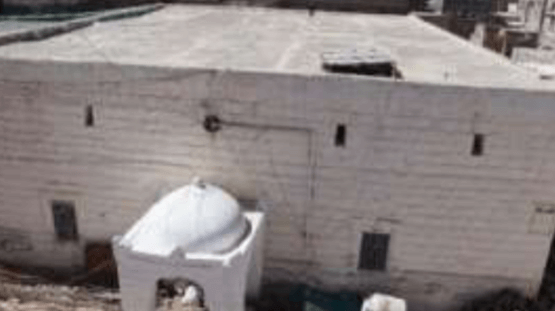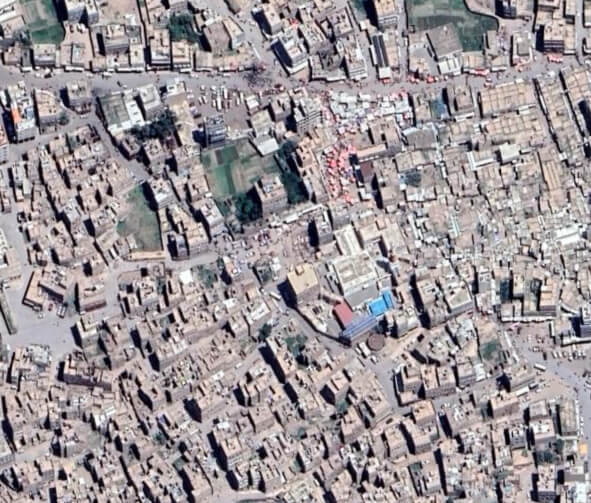
Al-Shamsiyyah Mosque and Madrasah – Dhamār
جامع ومدرسة الشمسية – ذما ر
Monument description
It is one of the famous historical mosques in the old city of Dhamar. It consists of one floor, with a flat ceiling. It was historically known as AL-Madrasaa, but it is not similar to schools in its design. Religious sciences were taught in the Zaydi sect, and the students’ homes were built around its construction. It is located in the Al- Jarajish neighborhood of Dhamar city. It is bordered on the north by the Al-Rabu` market, on the east by Al-Majn market, on the west by the Governorate Awqaff Office, and on the south by Al-Jarajish neighborhood. The mosque and the school function is for teaching religious and language sciences for students and scholars known to contain people with special needs who have lost their eyesight. It provides housing for students coming from outside the city as well.

Architectural and cultural value
Construction style and built date: The layout of the AL-Madrasaa AL- Shamseiaa coincides with the layout of the mosque. It is basically a rectangular prayer house of 22 x 17.5 m, built of black stone. It has a flat roof, and its inner courtyard is based on four rows of columns and arches parallel to the qibla wall. (Yajor) brick was used in building the upper parts of the minaret and some houses. AL-Madrasaa AL-Shamseiaa was built in the year 950 AH by Imam AL-Mutawakkil Sharaf AL-Deen Yahya ibn Sharaf AL-Deen. The building of the school was completed by Imam Shams AL-Deen, to whom the school was attributed in Jumada al-Akhir 947 AH until its construction was completed in Ramadan (950 AH – 1544 AD) during the reign of his father. It is considered one of the famous abandonment of science in Yemen, and students from Dhamar and other regions of Yemen come to it to study there, and for those coming to it from outside the city of Dhamar, there are private residences attached to the school, in which many Yemeni scholars studied, especially scholars of the Zaydi sect, including Ibrahim bin Youssef and Mahdi bin Ali. The judge, the scholar Ali Bin Hussein Al-Akwa, the scholar Yahya Mohsen Al-Ansi, the scholar Hassan Bin Yahya Al-Dailami, the late writer Abdullah Al-Bardouni, the late writer Ibrahim Al-Hadrani, the writer and martyr Zaid Al-Mushki, the writer Ahmed Abdel-Wahhab, the heir and the famous politician Jarallah Omar.
Components of the Mosque: The school consists of a prayer house and roofed Matahir (ablution unit) to its north, a southern courtyard, a southern pond, an eastern pond, and the students’ homes that surround the school and modern bathrooms on the southwestern side. A concrete school was built in the place of the eastern ponds and Matahir. The school has an external Garden, 200 m in the eastern direction, and a water drainage network extends to it that passes through the middle of the market. The area of the Monument with the courtyard and annexes is about 2785 m2.
- Justifications for intervention:
- 1 – To stop the state of deterioration in the foundations, walls, and ceilings of houses, and to remove and stop the state of deterioration and damage to the foundations, walls, and ceilings of the eastern gate.
2 – Carry out maintenance work for the roof and walls of the prayer house.
3 – Carry out maintenance work for AL-Qudad layer in the minaret.
4 – Cleaning stone buildings, domes, and walls from new and random paints.
- Monument conditions and treatment:
- Its general condition is average with regard to the prayer house building and the northern Matahir (ablution unit). As for the houses, their structural condition is very poor, and they have been subjected to many random changes and developments, some of which were demolished during previous intervention stages:
The most prominent damage:
1. Erosion of the layers of Qudad on the roofs and walls of the building and annexes.
2. Removal of the old Bathrooms and the pond that located on the eastern side of the monument
3. Construction of concrete buildings.
4. Damage to the walls, foundations and ceilings of the eastern gate.
5. Damages to houses, random interventions, and changes to them with the use of cement
6. Damage to the cladding layers in the minaret
7. Some door locks are missing, and the wooden elements has been painted with oil paint.
8. Covering buildings of stone with AL-Nuora and oil paint.

Countries






